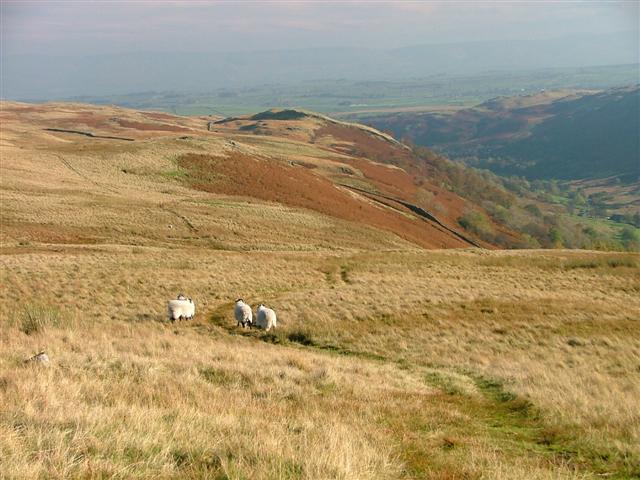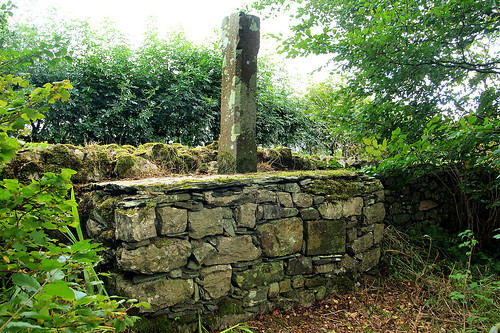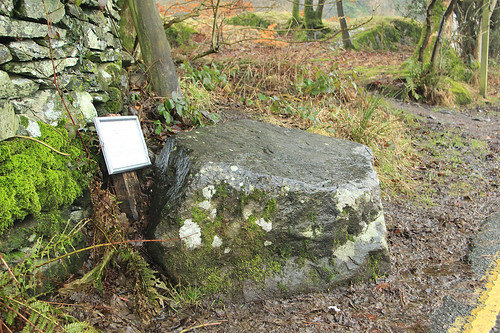Corpse roads might conjure up weird mental images of highways paved with the dead, or possibly byways only used by them. But they’re actually more straightforward than they sound.
In days gone by, remote communities often had nowhere nearby to put their dead. Only the churches held burial rights, but they could be miles away from the smaller villages. Corpse roads connected the graveyards to the small communities, granting access to consecrated ground.
In the UK, corpse roads are sometimes called burial roads, funeral roads, or lych ways. As you can imagine, they’ve become pretty associated with wraiths and ghosts.
The name pretty much says it all.
If you’d rather listen, hit play below. Otherwise, keep reading…
Come with me. Let’s take a walk along the old corpse roads…

In 1736, the town gained the new Holy Trinity church, allowing the burial of Mardale’s dead closer to home. But just look at that photo. The sheep don’t seem particularly bothered by any spectres.
Mardale itself now lies at the bottom of the Haweswater Reservoir. The authorities submerged the village in 1939. They transferred 97 sets of remains from the churchyard to Shap.
Seems the dead of Mardale were destined to lie in Shap come hell or high water – literally.

A lot of the old corpse roads now only exist as footpaths. For the latter, few remember or know their original purpose. Sometimes fields give them away, especially if they’re called something like “Church-way”.
But it usually takes a combination of old maps, local knowledge and the occasional legend to plot their course. Atlas Obscura point out the locals didn’t want rotting bodies carried across their land. That explains the remoteness of the paths.
According to Philippa Waring, land becomes a public right of way if a corpse is carried over it (1978: 66). And Wm. Self. Weeks notes a belief in East Lancashire that the passage of three funerals over a road made it a public highway (1928: 393). It’s not enshrined in British law so it’s probably a holdover from the time when the only people using the paths were pallbearers.
Weeks also believes the adoption of hearses even by “the poorer classes” led to the decline in corpse roads (1928: 395). On top of that, the Enclosure Awards divided ‘common land’ up. Many boundaries cut across corpse roads and mourners had to be persuaded to use actual highways.
How do corpse roads link to folklore?
There are certainly plenty of tales surrounding them. Superstitions ran a lot higher in days gone by. People believed spirits travelled in straight lines. One way to stop ghosts returning to their home involved taking a meandering route to the graveyard. That possibly explains why corpse roads gently wend their way through the countryside instead of taking a direct route.
Many feared bad luck if a different path had to be followed, for whatever reason. This is possibly due to the fact that the corpse had to be taken along an actual corpse road to prevent them returning home later on.

Then you have the corpse candle, particularly associated with Wales. People believe it travels along the route from the cemetery to the dying person’s house and back again. Seen as an omen, the lights allegedly appeared on the night before a death when the spirit traced the path to the cemetery in advance.
As with most legends, some confuse these corpse light with the will-o’-the-wisp, a mischievous spirit that tried to lead travellers astray (often into marshes). Kira Butler has an excellent post on these corpse lights. To play Scully for a moment, the possibility remains that such lights did exist…produced by the methane gas produced by decomposition.
Apparently, barn owls can also be luminescent in some instances, so perhaps the locals just saw glow-in-the dark birds.
Other legends abound. According to Legendary Dartmoor, mourners carried the corpses feet first, so they pointed away from their home. Sometimes the road would cross bridges or stepping stones, since spirits couldn’t cross running water. A lot of effort went into making sure the dead didn’t come back to haunt the living. It’s almost the total opposite to the attitude towards the deceased in Mexico’s Day of the Dead celebrations.

The Coffin Rest
Some of the corpse roads featured coffin stones to allow mourners to set the coffin down while they rested. The coffin therefore didn’t touch the ground, which apparently stopped the spirit from wandering off!
Lamplugh in Cumbria is one such location to boast a coffin rest, also known as a corpse cross. It’s near the church and gave pallbearers somewhere to put the coffin while they caught their breath.

Depending on the route, some pallbearers might have carried the coffin for up to twelve miles. There’s another coffin rest in Grasmere, once home to William Wordsworth. While it’s a different style, it performed the same function as the one in Lamplugh.

There’s also another form of coffin rest from the 18th century. Churches might have a ‘parish coffin’ to be used by the very poor. Their family wrapped them in a shroud and borrowed the parish coffin to carry them to their grave.
The family buried the body but returned the coffin to a ‘rest’ in the churchyard. Right until the next person needed it.

A lot of the surviving corpse roads are just meandering paths now, their original purpose lost in the mists of time. But for those that still have their crosses and coffin stones, they remain a slightly eerie pathway through the English landscape.
Would you ever follow a corpse road? Let me know in the comments!
Interested in corpse roads? I wrote a short story about one, which you can find in your free copy of my short story collection, Harbingers: Dark Tales of Speculative Fiction! Download it below.
References
Waring, Philippa (1978), Dictionary of Omens and Superstitions, London: Souvenir Press.
Weeks, Wm. Self. (1928), ‘Public Right of Way Believed to Be Created by the Passage of a Corpse’, Folklore, 39: 4, pp. 393–398.
Get your free book of short stories!
"Creepy mummies, ghosts, ghouls, and the paranormal" ⋆ ⋆ ⋆ ⋆ ⋆
You'll also get my monthly email including free short stories, book recommendations and other fun stuff.







This is such a great post. I didn’t have a clue were the name came from and I love these types of stories.
xo Anne
Glad you liked it!
Interesting stuff. The Hmong/Miao people in southern China have corpse roads, and corpse hotels. Tradition says that the dead must be “walked” home to their birthplace. Usually the specially employed corpse walker carries the corpse strapped to his back, but legend has it some corpse walkers lead lines of walking dead people, stopping at the hotels of the dead along the way.
The Chinese tradition of burning fake paper money at grave mounds for the dead seems to me to be equivalent to the offerings of bent coins at “fairy mounds” in the west
That’s fascinating! Thank you for adding that. Do you have any reading recommendations so I can find out more?
Awesome article!! I wish I’d known about these before my trip to England; but we came back literally (June 14) just before you published it. That’s okay, now I have the information for my next trip! Thank you so much, this is such a cool twist to walking paths!
I’ll see if I can follow some myself!
Thank you for the article on such an interesting subject; very informative. I would love to walk the paths of some of these old roads.
I’m going to try and follow some and take photos!
Very interesting!
Thank you!
They were also called coffin roads. There is one between Newbiggin On Lune and Ravenstonedale in Cumbria.
Have you ever followed it?
Good to find a kindred spirit. This article is fabulous — I wish I’d found it when I’d compiled my corpse lights research post (here: http://www.kirabutler.com/my-creepy-search-history-corpse-lights/)
Nonetheless, excited to read Harbingers. You’ve got a new follower. 🙂
Hurray! I’m glad you enjoyed the post. And I hope you enjoy Harbingers!
That’s an idea, not a fact, about the particular road.
Too much confusion between ideas and facts, recently, and with bad effects.
Which part is the idea you’re referring to, rather than the fact?
I missed this when you first ran it. Are walking tours still a thing in the UK? Seems like that would be a quirky variation.
Yeah, walking tours are big business. But yeah, corpse roads could prove some interesting routes!
I can recommend the Coffin Route to Alcock Tarn in Grasmere, a lovely circular route, not too tough but a bit of a work-out. There are resting stones for the coffins along the first part of the route. Make sure you leave by 10:30 if you want to make if for lunch back in Grasmere – or take a packed lunch and eat it by the tarn.
https://www.nationaltrust.org.uk/allan-bank-and-grasmere/trails/alcock-tarn-walk
This is fantastic. Thanks for sharing! I thoroughly enjoy your folklore work. Especially when you help me to win an argument! Lol Just curious about the corpse candles which I thought were also Scottish and stationary. I have to find the book again but it refers to corpse candles as supernatural grave markers for bodies of murder victims who were never found…
This is so cool. And, yes, I would totally take a walking tour of a corpse road. Have you read the YA series “Raven Boys” by Maggie Stiefvater? She has “ley lines” in there and at least one of them has a corpse road running along/through it.
Ooh I’ll have to check that out!
I’ve never heard of these before — so interesting! They sound like a great way to have a countryside/historical hike.
Great post! I’d love to walk a corpse road. I think it would be interesting, though I might not want to walk it (at least not the first time) alone in the dark. I’d want to dispel any residual creepy feeling I might have first. 🙂
Yeah, it’s more of a ‘take a friend’ deal!
I was in Grasmere in Cumbria in 2013 and found a terrific circular walking route that went along the Corpse Road there. Grasmere had been the home to the poet William Wordworth and I was there during the spring so was delighted to see a host of golden daffodils, just like his poem, at the bottom of the corpse road. It was quite a steep climb – it really would have been difficult in bad weather. I wondered why they wouldn’t have gone along the normal, flatter road, but maybe you couldn’t because of the supertitions. There were some really narrow parts…and there were one of two large stones that I guess would’ve been corpse stones, to rest the coffin. I am very interested in all of the folklore of the UK and had been fascinated about Corpse roads, so I had to do this walk. Not only was the view back over Grasmere lake stunning, but walking along this path had a strong effect on me – maybe imagining how many people had been carried over this path for centuries .
Lovely site, great to share these ideas.
This is part of the circular route
http://www.gazetteherald.co.uk/leisure/countrywalks/11121293.Country_walk_at_Grasmere_in_the_Lake_District/
Grasmere is a lovely little town with the most heavenly gingerbread, and of course William Wordsworth had lived there.
Ah yeah, I went to Dove Cottage years ago when we were studying Dorothy Wordsworth’s journals for A Level English! I had no idea there was a corpse road there though. I’ll have to pop back and try walking it!
The coffin route between Ambleside and Grasmere is a great walk and I’ve often thought about the pallbearers as some of the terrain could have been tricky when carrying a coffin. The coffin rest stone must have been a relief to see!
As weird as it sounds, I’d love to follow it! It would be great to get a sense of how these routes cut through the landscape.
Walked one this summer from Muker to Keld over https://www.atlasobscura.com/places/swaledale-corpse-way. Didn’t see any ghosts just sheep. Also didn’t Paul Devereux do a article on corpse paths in the Fortean Times a few year ago.
It’s entirely possible. I actually wrote this in 2016 and only just updated it – I’ll have to see if I can find that issue.
wow this was a real interesting article, i wonder if we have such roads in my own country but yes i definitely would follow a corpse road if i knew there was one!! scary but exciting!!
Very interesting article, makes me wander if we have something similar in the U.S.?
Fantastic article. I love your podcasts. I would definitely walk a coffin path
I’m hoping to track some down over the summer!